Thai red curry is one of our favorite dinners. Succulent, juicy shrimp, in an aromatic sauce with tender and sweet pumpkin and spinach. This curry is packed with flavor, easy, and comes together in no time.
For more Thai recipes, check out my Thai coconut sticky rice with mango!
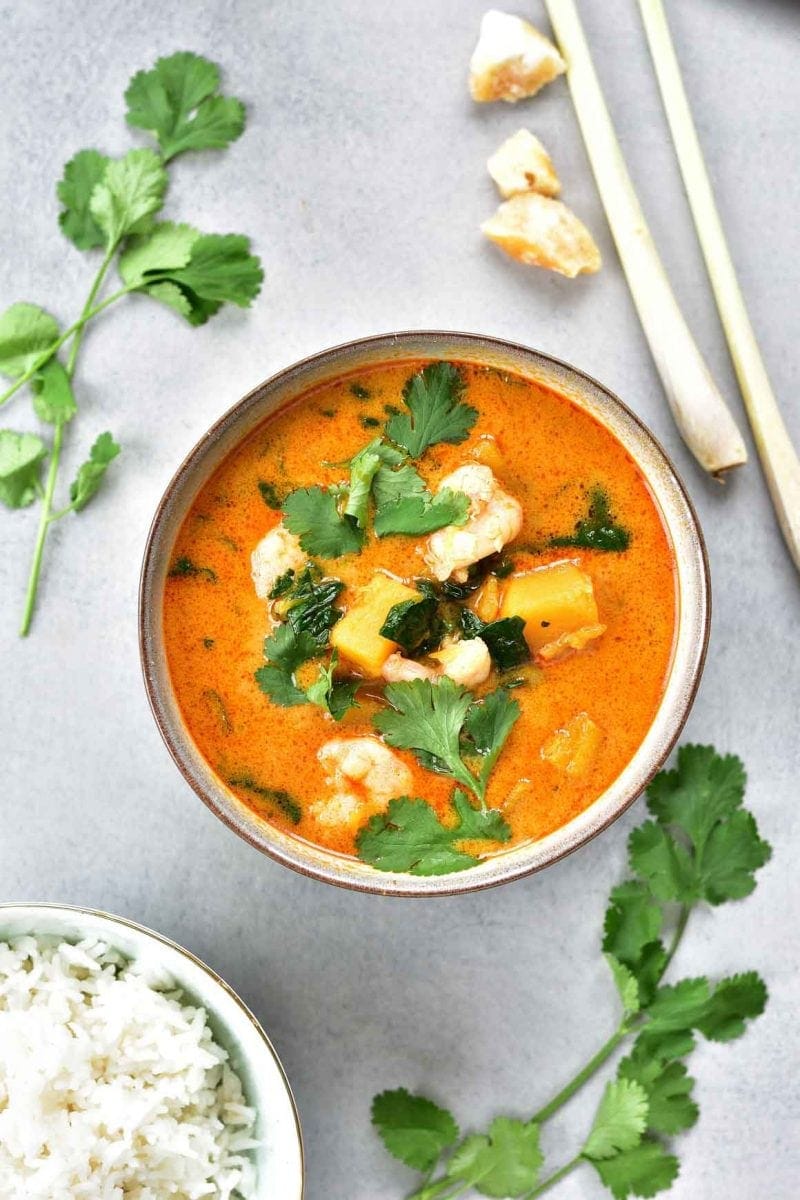
Ingredients and substitutions
You can get all the ingredients for an authentic Thai curry at a well-stocked supermarket, in an Asian store, or on the internet. Since you already need to buy Thai curry paste, as this is one ingredient that you just can not omit, it’s also good to look for the other traditional ingredients and enjoy the wonderful and authentic taste of this popular dish. The curry paste and sauces have a long shelf life, so once you buy them, you can store them in the fridge for a long time and make tasty curries many times. Vegetables can be freely changed, depending on what you have on hand, keeping the curry base unchanged.
Here’s what you need to make this curry:
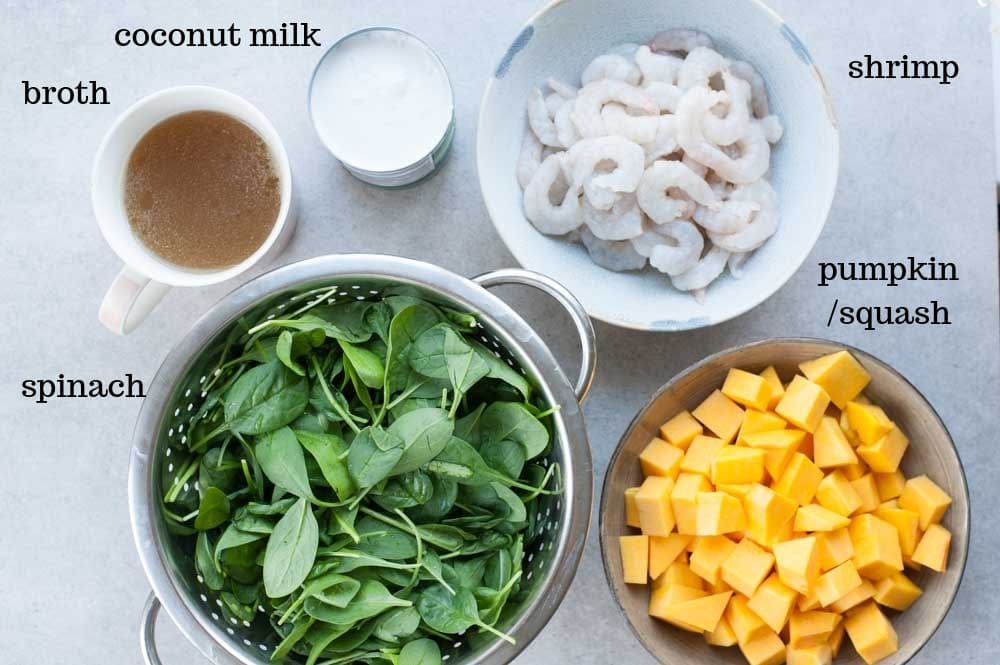
The base of any red curry
- Red curry paste – This is the base of the curry. The authentic curry paste is made of hard to get ingredients, so it’s best to buy a ready-made one. Please read the ingredients list on the package and choose that paste that lists only spices and aromatics, but no artificial ingredients. The pastes can vary depending on the brand – some are more aromatic, and some are spicier than others. If you don’t like very hot dishes, make sure to choose a red curry paste that is not overly spicy (it’s best to try them before adding it into a pot, it should be spicy but it should not completely numb your tongue). Most pastes that I’ve tried are moderately hot. I’m also adding ginger, garlic, and lemongrass to the store-bought paste. Garlic and lemongrass are already ingredients of my curry paste. The curry paste is good and aromatic but when I don’t add these fresh ingredients I always feel there is some flavor lacking. If you find your paste aromatic enough you don’t have to add this. Ginger is not a red curry paste ingredient and should not be substituted for galangal, but I personally like its taste in this curry (these two spices look similar but their flavor is different). This recipe will also work with green or yellow curry paste.
- Coconut milk – it’s best to buy coconut milk that lists only two ingredients (coconut and water) and doesn’t contain any stabilizers. For the best flavor, use full-fat coconut milk. The coconut content should be at least 60%. Try to not shake with the can prior to opening it. Natural canned coconut milk should separate into two layers: top coconut cream layer (very thick and white) and coconut water layer at the bottom – looks like cloudy water. You need to scoop a part of this thick cream layer from the top, add it to the pot and cook with the curry paste. If your coconut milk hasn’t separated, you can cook your paste in a tablespoon of vegetable oil.
- Broth – for the best flavor use chicken broth, but vegetable broth or even water will also work. You could also add coconut milk instead of broth, but I prefer this lightened-up version, with coconut milk:broth 1:1 ratio.
- Lemongrass – can be omitted, but I really recommend adding it as it adds wonderful, fresh, lemony flavor. You can also use store-bought lemongrass paste.
- Seasonings: they are used to add saltiness, sourness, and sweetness to the dish. Providing exact measurements is not accurate, as these products vary from brand to brand. Add them to your taste. If the curry is not enough salty – add more fish sauce, not sour enough – tamarind paste, not sweet enough – sugar. It can also vary depending on your preferences. I remember, a good couple of years ago, when I just started to learn Thai cuisine, I’ve been adding a lot less fish sauce to this dish that I’m adding today, its flavor was too strong for me, but now I’m accustomed to it.
- Fish sauce – adds saltiness to the dish and umami flavor. It is one of the most important ingredients in Thai cuisine. It is used like salt in Western countries. It is called nam pla or nahm pla in the Thai language, which means fish water. Make sure it says so on the bottle and don’t confuse it with oyster sauce. Fish sauce has the consistency and thickness of soy sauce. Oyster sauce is much thicker. Fish sauce is made from fermented fish. The ingredient list should include fish, water, and salt (not sugar, caramel, MSG, any artificial coloring and flavorings). If it tastes too fishy for your liking, just try another brand.
- Tamarind sauce – adds sourness. Tamarind paste can be replaced with lime juice, although it lacks its fruity sweetness.
- Palm sugar – adds sweetness. Palm sugar is made from a coconut palm tree and it’s really delicious, it tastes like lemony brown sugar. You can add coconut sugar or brown sugar instead. It’s sold either in blocks, that need to be crushed or in jars and have a consistency of honey.
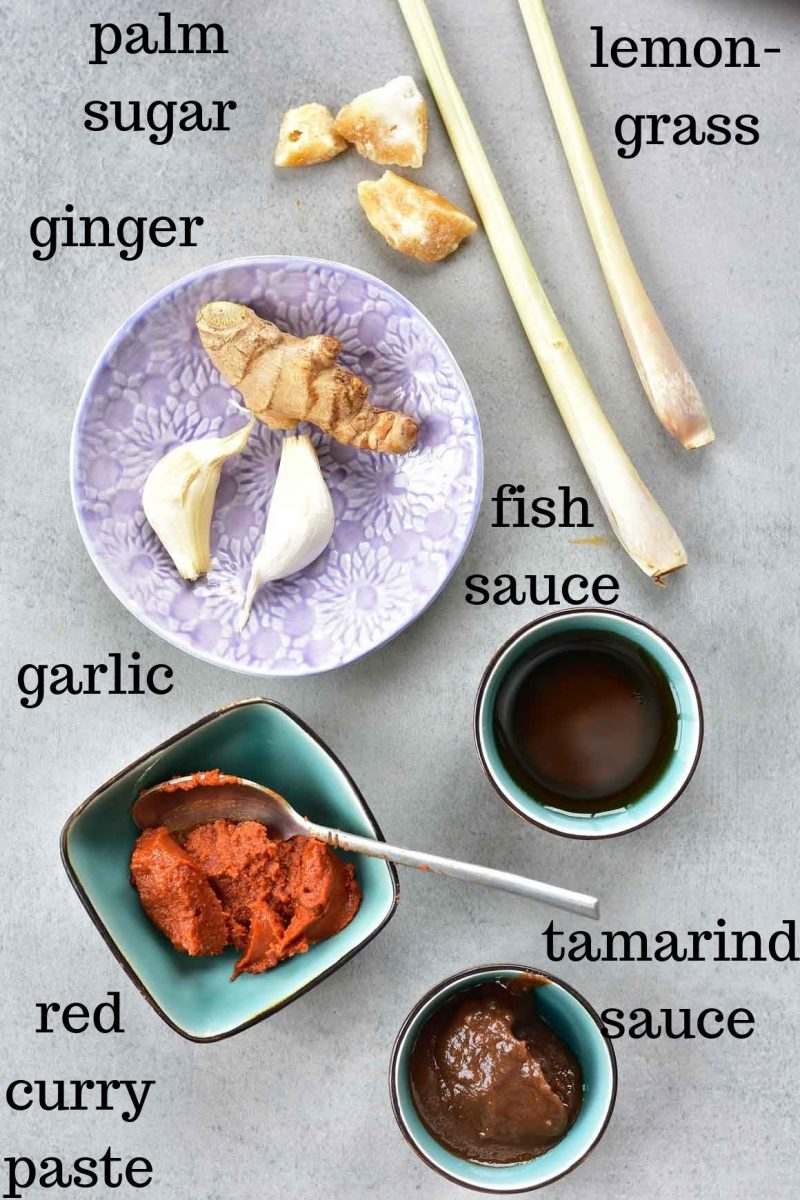
Additional ingredients
- VEGETABLES – you can add any vegetables that you like, adjusting cooking time to each vegetable. I added pumpkin/squash – it adds sweetness, soaks up the sauce, and naturally thickens the curry. You can add any pumpkin type, that you like. Much preferred would be orange-colored pumpkin as opposite to yellow-fleshed, but only because it looks nicer (fish sauce and tamarind sauce have deep brown color). Out of the pumpkin season, you can use sweet potato. I also added spinach, but it can be easily omitted.
- MEAT/PROTEIN: My recipe uses shrimps. They come out delicious, succulent, and juicy – all thanks to the preparation method I’m using – poaching the shrimp. They don’t need to be cooked, just add them to the hot broth and they will be ready in about 3 minutes. Overcooked shrimp will be tough and rubbery. Instead of shrimp you could add poach salmon or any other fish or add chicken breast.
For this recipe, you’ll need thawed, peeled, and deveined shrimp. This is a great article, which explains how to peel and devein shrimp. - How to make it vegetarian – you need to buy red curry paste that is vegetarian-friendly (doesn’t contain shrimp paste), instead of fish sauce you can use soy sauce (but bear in mind, that the flavor will differ from an authentic curry), then omit the shrimps. You can add baked or pan-fried tofu or canned chickpeas, for more protein.
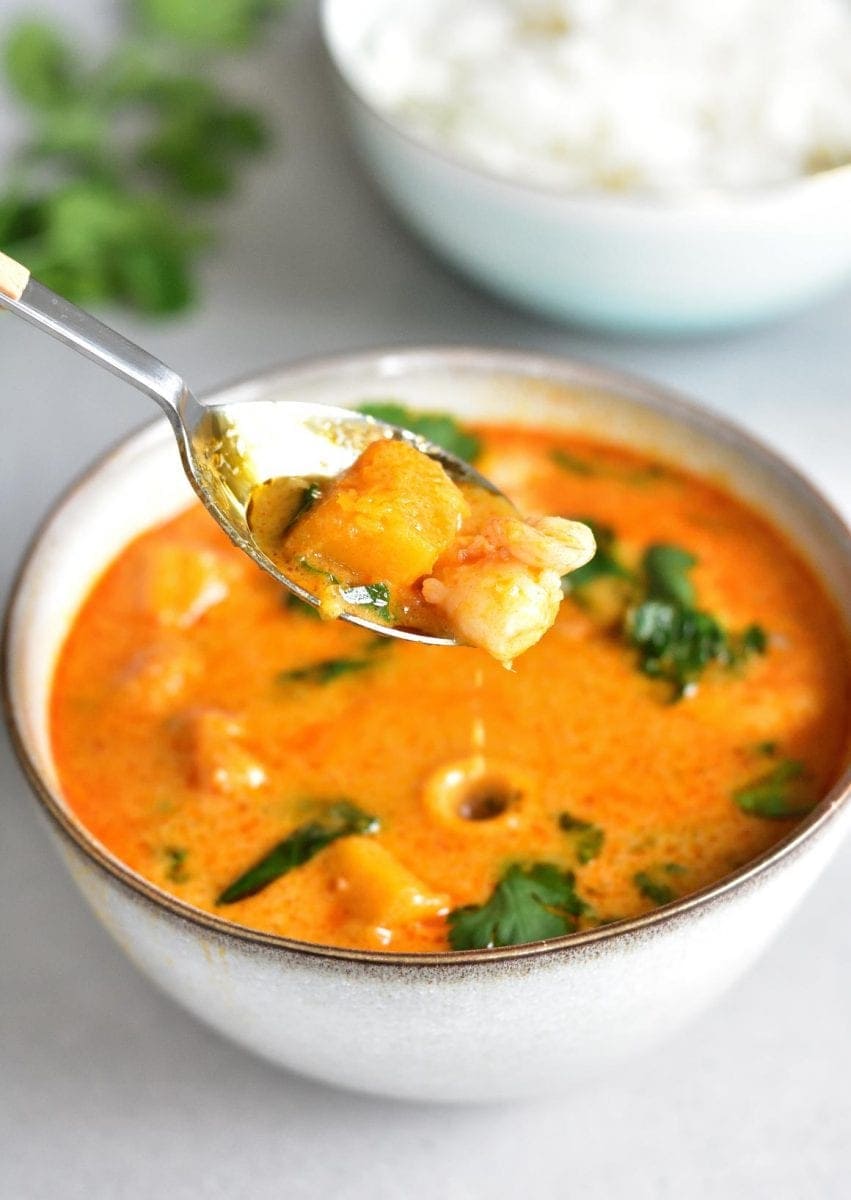
How to make authentic Thai red curry step by step
STEP 1: Open a can of coconut milk (do not shake with the can), a thick mass should be at the top (coconut cream), and thin liquid at the bottom (coconut water). Spoon out about 2/3 of the cream, add to a large pot, heat over medium heat until bubbling.
STEP 2: Add the red curry paste, finely chopped garlic, ginger to the pot.
STEP 3: Add bruised lemongrass stalk and cook the paste for about 2 minutes or until fragrant.
STEP 4: Add the cubed pumpkin, cook for a minute.
STEP 5: Pour in the coconut milk and broth, cook for another 10 minutes, or until the pumpkin is tender.
STEP 6: Poach the shrimp.
STEP 7: Add the spinach. Stir the curry until the leaves are wilted.
STEP 8: Season the curry: add finely crushed palm sugar, fish sauce, and tamarind paste to taste. If the curry is not salty enough – add fish sauce, not sour enough – tamarind paste, not sweet enough – more sugar.
Serve and enjoy!
How to poach shrimp
- Use peeled, deveined, and thawed shrimp.
- Add the shrimp to a pot of hot water. The water should be very hot and steaming, but should not be boiling. Take the pot off the heat.
- Stir the shrimp in the pot until cooked through. It should take about 3 minutes. The shrimps are ready when they’ve changed their color to pink and are no longer gray/translucent. The cooking time will depend on the amount of shrimp / how big the pot is / how much liquid is in the pot. Take one shrimp out and cut it in half to check if it’s cooked through.
How to check if the shrimp is cooked through: it will change its color from grey/translucent to white/pink.
Adjust the spiciness
- do you like fiery hot dishes? add fresh chopped chilis as a garnish
- if your curry came out too hot – add more coconut milk and broth to dilute the chili flavor. The taste of your curry will be more mellow, so make sure to season it to your taste (as mentioned above: more sugar for sweetness, more fish sauce for saltiness, more tamarind sauce/lime juice for sourness).
How to serve this dish
- Red curry can be served as soup (without any additions).
- I served it with rice. It’s best to use Jasmine rice, which is very fragrant and flavorful. Coconut rice or cilantro lime rice would also be lovely.
- Instead of rice, you could serve it with angel hair pasta, thin rice noodles, quinoa, brown rice, or any other grain that you like.
- Sprinkle with fresh coriander leaves or Thai basil and/or chopped fresh chilis if you like more heat!
How to cook Jasmine rice
The rice to water ratio is 1:1. Rinse the rice thoroughly until water runs clear, cook it with 1 teaspoon of coconut oil (or vegetable oil) in a medium pot, add the cold water and 3/4 teaspoon salt, bring to a boil, cover, cook over very low heat for 15 minutes (don’t stir during cooking and don’t lift the lid). Take off the heat, leave to rest for 10 minutes. Fluff with a fork and enjoy.
Storing tips / meal prep
- I would omit the spinach, as it will become totally wilted and won’t look very appetizing.
- Store the curry without the rice/noodles, or they will soak up the sauce and be soggy.
- Be careful when reheating the curry to not let it boil (you will overcook the shrimp), just warm it up until almost boiling. When making vegetarian red curry, this is irrelevant.
- The curry can be stored in the fridge for up to 3 days or can be frozen for 3-6 months (don’t freeze the curry if you’ve used frozen shrimp or vegetables to make it).
FAQ:
This is actually a sign, that your curry was properly made! For more on this subject, you can read this article from my Thai curry.
Homemade curry paste is much more flavorful, but if you can’t find all the fresh ingredients for red curry paste (listed below) than it’s better to buy ready-made red curry paste.
You can add any fresh red curry ingredients, that you can find. An authentic red curry paste contains: galangal, lemongrass, kafir lime peel, coriander root, shallots, garlic, shrimp paste, and chili peppers. Adding fresh lemongrass to infuse the sauce makes the biggest difference for me. I also added fresh garlic and ginger. Ginger is not a red curry paste ingredient and should not be substituted for galangal, but I personally like its taste in this curry. These two spices look similar but their flavor is different.
This can happen if your coconut milk contains stabilizers, which prevent coconut milk from separating. The second reason could be that you have shaken with the can prior to opening it.
This can happen if you’re using low-quality coconut milk (it has a very low coconut extract percentage, which means that a part of coconut was swapped for water). My curry recipe will be also a little more watery than regular, 100% coconut milk curry, as I’m also using broth to make it.
Did you make this recipe? RATE THE RECIPE or tell me in the COMMENTS how you liked it! You can also add a photo of your dish. It would make me very happy and will help other readers. Thank you!!
Thai shrimp, pumpkin and spinach red curry
składniki
red curry:
- 1 (14-oz/400ml) can coconut milk
- 1 ⅔ cup chicken/vegetable broth 400 ml
- 3 tablespoons Thai red curry paste or to taste
- 2 cloves garlic
- 1- inch (3 cm) piece of ginger
- 1 stalk lemongrass optional
- 1.3 lbs butternut squash/pumpkin 600g (skinless, seedless), this is about 2 lbs/1kg whole butternut squash
- 1 lb (450g) shrimp peeled and thawed
- 2 large handfuls spinach 4.4 oz/125g, can be omitted
- 3 tablespoons fish sauce
- 2 tablespoons tamarind paste or less lime juice
- 1- inch (3 cm) piece of palm sugar or light brown sugar
to serve:
- 1 cup jasmin rice 180g
- fresh coriander leaves
Would you like to save this?
wykonanie
Prepare the ingredients:
- Thaw the shrimp (just put them into a bowl with cold water for 10 mins).
- Chop the ginger and garlic very finely or pulse them in the food processor with the curry paste until smooth (if it's too thick, add a little coconut milk to thin it out).
- Bruise the thick part of lemongrass with a knife handle.
- Peel the pumpkin/squash and cut into 1/2-inch (1.5 cm) cubes.
Cook the curry:
- Open a can of coconut milk (do not shake with the can prior to opening it), a thick mass should be at the top (coconut cream), and thin liquid at the bottom (coconut water). Spoon out about 2/3 of the cream, add to a large pot, heat over medium heat until bubbling and oil begins to separate from the cream (if this is not happening, just continue with the recipe).
- Add the red curry paste, garlic, ginger and lemongrass to the pot and cook over medium heat for about 2 minutes or until fragrant.
- Add the cubed pumpkin, cook for a minute.
- Pour in the remaining coconut milk and broth, cook for another 10 minutes over medium-low heat, or until the pumpkin is tender (cooking time depends on the type of pumpkin and how big the pieces are, adjust accordingly).
- Poach the shrimp: Set your heat to the minimum – the curry should be very hot and steaming, but it should not be boiling. Add shrimps to the pot, then take the pot off the heat. Leave for a couple of minutes (about 3 minutes), stirring from time to time (shrimps should be submerged in the broth). You can take one shrimp out and cut it in half to see if it's cooked through (it will be white/pink in the middle instead of grey/translucent).
- Add the spinach and stir the curry until the leaves are wilted.
- Season your curry: add finely crushed palm sugar, fish sauce and tamarind paste to taste. If the curry is not salty enough – add more fish sauce, not sour enough – tamarind paste, not sweet enough – more sugar.
- Serve with rice and sprinkle with fresh coriander leaves.
- Enjoy!
uwagi
- If you’re making your red curry paste from scratch, omit the garlic, ginger, and lemongrass. Their job is to enhance the flavor of the store-bought curry paste.
- Vegetables: you can use any vegetables you have on hand. It can be fresh or frozen. Instead of pumpkin/squash, sweet potato is a good substitute. Pumpkin cooking time may vary, depending on pumpkin/squash type and how big the pieces are.
- Lemongrass: can be omitted. You can also use store-bought jarred lemongrass paste.
- Instead of shrimp, I would add chicken breast (poached in hot broth like shrimp or pan-fried) or any other protein source that you like: chicken thighs, steak, tofu.
- If your curry has split (red oil droplets are floating on the top), this is how an authentic curry should look like.
- How to cook Jasmine rice: The rice to water ratio is 1:1. Rinse the rice, cook it with 1 teaspoon of coconut oil (or vegetable oil) in a medium pot. Add the cold water and 3/4 ts of salt, bring to a boil, cover with a lid, cook over very low heat for 15 minutes (don’t stir during cooking). Take off the heat, leave to rest for 10 minutes. Fluff with a fork and enjoy.
- Spinach leaves: if you’re using big and older spinach leaves (and not baby spinach), cook them for 1 minute or until the leaves are wilted, before adding the shrimp.
- Calories count = 1/4 of the recipe, including rice. This is only an estimate!


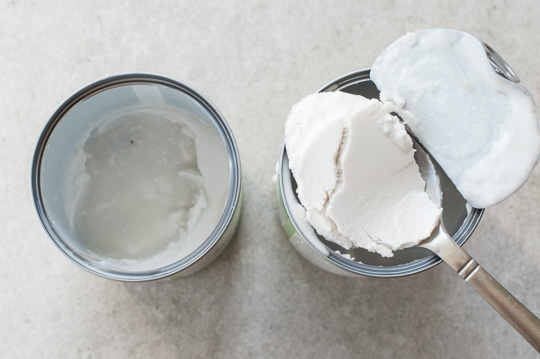
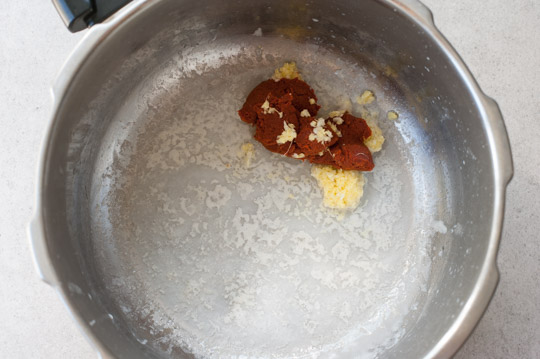
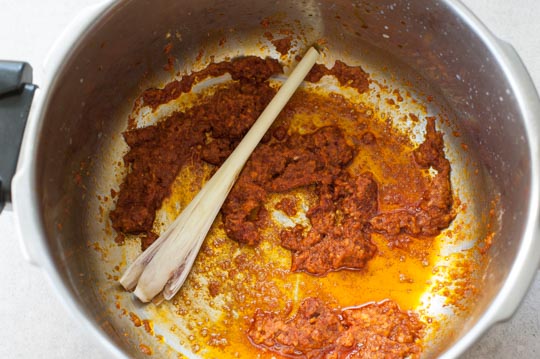
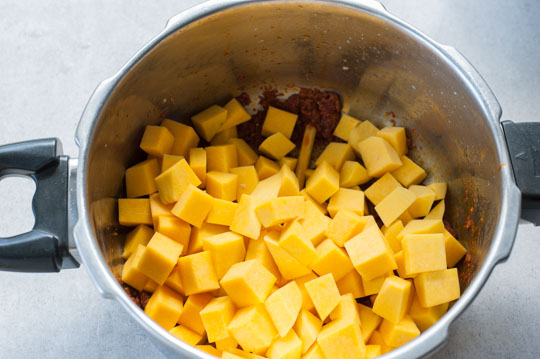
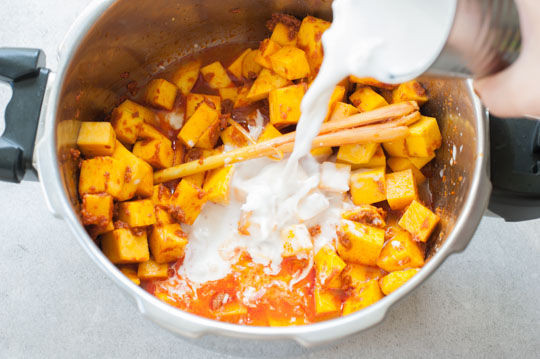
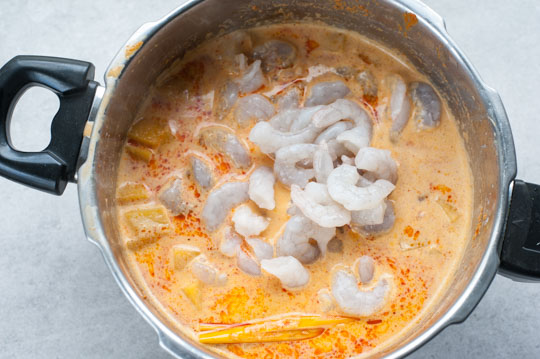
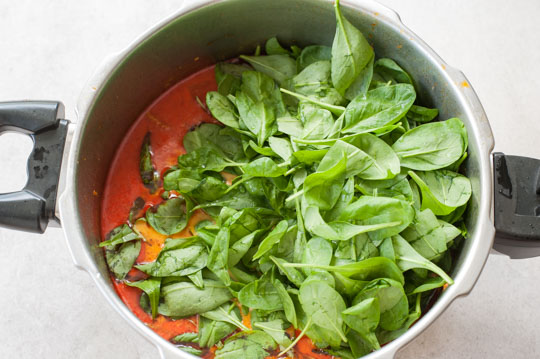
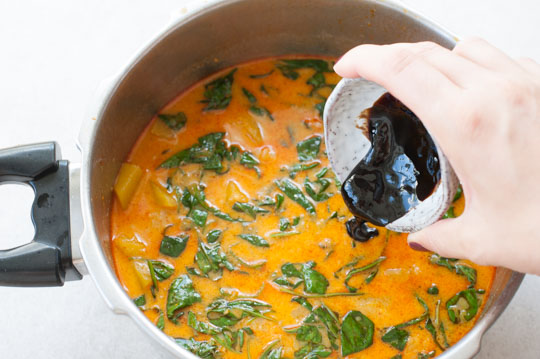
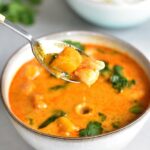
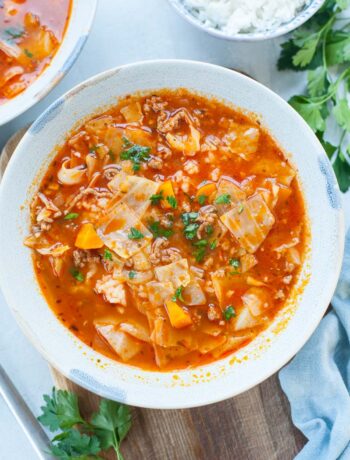
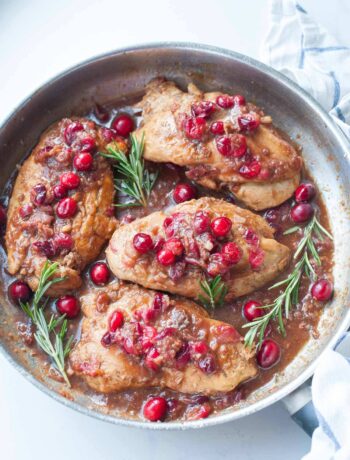
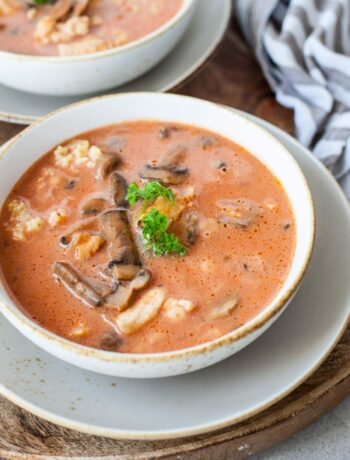
Brak komentarzy